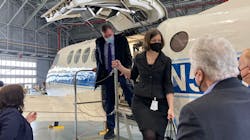NASA Langley Works to Revive Supersonic Flight — Without Sonic Booms
There was plenty to gape at as NASA Langley Research Center staff briefed members of Virginia’s Capitol Hill delegation — but it was the slender, streamlined X-59 with its promise of supersonic flight without sonic booms that may have best exemplified the work of the nation’s oldest aeronautics lab.
It is the product of new computational tools that allow NASA designers to explore previously unthought-of shapes for aircraft — in particular, how their movement generates changes in the atmosphere that turn into ear-shattering sonic booms, Paul Coen, mission integration manager for Langley’s low boom project, explained.
The shape designers came up with is a needle-nose so long and narrow that they couldn’t put a window in it that would give pilots enough of a view.
So they came up with a camera system enhanced with radar and other sensors, Coen said.
“When you think of how much technology has changed in 40 years when air travel really hasn’t, this is a game-changer,” said Sen. Mark Warner, after an intense one-on-one with Coen. “Think of it, supersonic flight that’s affordable.”
Sonic booms are why there aren’t any supersonic airliners carrying passengers these days — they’re banned from flying fast enough over land to generate sonic booms, and that makes them uneconomic and inefficient. The last, the Concorde flown by British Airways and Air France, were grounded in 2003.
Coen believes the X-59, slated to start test flights next year, will make a noise as it passes overhead not any louder than the slamming of a car door.
Taking flight to test theories and then wind-tunnel experiments with spacecraft heat shields and parachutes is another effort at Langley, which has developed shields with reams of sensors as well as an inflatable shield that will act as a brake on spacecraft approaching Mars.
“We want to be sure people get home to their families,” said Jennifer Inman, project manager for the center’s scientifically calibrated in-flight imagery efforts.
“Parachutes are particularly challenging,” she said.
Warner said he was intrigued by the center’s “people-mover” research — craft that NASA Administrator Bill Nelson said will mean “You’re going to be able to get on a people mover that’s going to allow you go from Norfolk to Newport News when the bridge is all tied up.”
Another new airplane design, this one featuring a version of the kind of strut that propped up wings on the old Piper Cub or small Cessna planes, promises more fuel-efficient flying, Warner said.
That’s because the airfoil-shaped struts in this design create lift — basically the same effect as increasing the size of the wings — which in turn reduces drag, or the resistance of the air, so that the plane needs less fuel, said Richard Wahls, technical advisor with Langley’s advanced air vehicles program.
Wahls’ focus on aircraft that have a smaller impact on the environment also tests alternative fuels, to see if there are ways to reduce carbon emissions and particulates in exhaust that contribute to climate change.
“There’s a lot of things going on here that will have a real impact,” said Rep. Robert C. Scott, D-Newport News, who joined Warner for the Langley briefings.
“We see lots of technology here, we see all the wonderful research that’s going on here but folks the thing that is a national treasure ... are the people who work here, the people who give their careers to advancing science” said Rep. Rob Wittman, R-Westmoreland.
“Whenever I come to Langley I clearly see that everyone here loves to come to work,” said Rep. Elaine Luria, D-Norfolk.
Dave Ress, 757-247-4535, [email protected]
©2022 Daily Press. Visit dailypress.com. Distributed by Tribune Content Agency, LLC.
